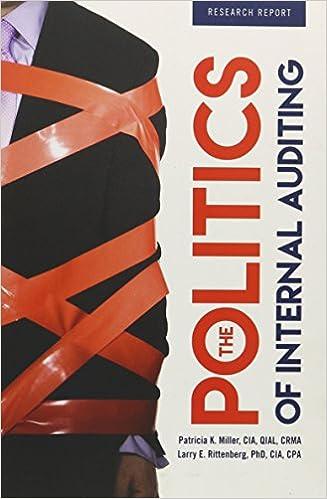Question
Now, CM 2 is considering a significant equipment replacement. Conner and Martin believe that the best time for this equipment replacement is at the end
Now, CM2 is considering a significant equipment replacement. Conner and Martin believe that the best time for this equipment replacement is at the end of 2013. However, they are concerned about the effects this replacement might have on their financial statements. The equipment originally cost $440,000 and after depreciation expense is recorded in 2013, the equipments accumulated depreciation balance will be $390,000. At this point the equipment will be fully depreciated to its salvage value.
Conner, Martin, Knepp, and Lopez tell you that they have thought of four options regarding the replacement of the old equipment. They could (1) construct the new equipment themselves and then sell the old equipment, (2) exchange the old equipment for new equipment that is more efficient, (3) purchase new equipment and sell the old equipment, or (4) overhaul the old equipment. When you heard this, you wondered about the current employees and whether acquiring new equipment will result in shifting jobs within the business and possibly lead to some layoffs. Because you are not sure how Conner and Martin will react to this concern, you decide not to bring up the subject at this time.
Conner and Martin appear increasingly confident in your analysis skills, and they have asked you to determine the effects of the above alternatives for replacing or upgrading this equipment. Knepp and Lopez have gathered the following information to help with this analysis.
Option 1: Construct the new equipment in-house and sell the old equipment for cash at a fair value of $60,000. CM2 would take out a one-year construction loan for $350,000 at the beginning of 2013 at a short-term borrowing rate of 10% for the construction. CM2 s present debt composition is as follows: (1) a $200,000 note at a 9% rate, (2) a $308,500 note at a 8% rate. Anticipated actual expenditures for constructing the equipment are $650,000, and on a weighted-average basis the expenditures are approximately $425,000. The bulk of the $650,000 will be financed with the construction loan, and the balance will be financed through accounts payable. The interest on the short-term note is due and payable by year-end. (Note: Construction is assumed to be completed at year-end.)
Option 2: Exchange the equipment for a similar piece of equipment with a fair value of $685,000. Knepp and Lopez have checked the secondary market and have found that the fair value of the old equipment is $60,000. They estimate that CM2 can borrow $350,000 on a one-year, 10% note at the end of 2013; the balance will be funded with an accounts payable arrangement with the supplier. (Assume the exchange has commercial substance.)
Option 3: Purchase the new equipment by giving a non-interest-bearing note with five payments of $164,000 to the supplier (starting on the first day of notes term and each year thereafter) and selling the old equipment for $60,000 cash. The first $164,000 payment would be made in late December 2013. The prevailing interest rate for obligations of this nature is 10%.
Option 4: Overhaul the existing equipment. The following expenses are anticipated under this approach: (1) The normal annual cost for lubrication and replacement of minor parts to maintain the integrity of the exterior body would be $27,000. (2) The cost of re-wiring interior components in an overhaul would be $125,000. (3) Replacing old worn components would cost $82,000 with associated labor costs of $210,000 for installation. The overhaul is estimated to extend the useful life of the equipment another four years. (The present equipments original useful life was eight years, starting January 1, 2006.) The costs will be financed at the end of 2013 through a one-year loan for $350,000 at 10%, and the balance will be charged on account.
Instructions
(a) Access the file, Excel Tables,
https://drive.google.com/file/d/0B-wGUKNWWg5jMWpmRWY5M3JXaEs5ZHdMLTdsSkx0UWk2TE4w/view?usp=sharing
from the Blackboard. For each of the four options presented, prepare journal entry(ies) in proper form in the proposed adjustments columns on the trial balance. This will require four separate spreadsheet files for the four options. For any loans created, record the current portion to the accounts payable line on the trial balance, and change the description to accounts payable and short-term debt (both on the trial balance and on the balance sheet). Record any long-term portion to long-term liabilities. Write a brief memo on how each option affects the financial statements. Include your journal entry(ies) in the body of your memo for each option. Discuss the strengths and weaknesses of each option.
(b) Since you are now in the process of analyzing the quantitative effects of this decision, you decide to also consider whether the acquisition of any new equipment will cause any employees to lose jobs. Also you wonder if there are other non-financial and/or ethical considerations you should include in your analysis. Write a memo describing other qualitative or subjective issues that you think Conner and Martin should consider in their analysis.
If possible, I would like a very in-depth response for part (b), please.
Step by Step Solution
There are 3 Steps involved in it
Step: 1

Get Instant Access to Expert-Tailored Solutions
See step-by-step solutions with expert insights and AI powered tools for academic success
Step: 2

Step: 3

Ace Your Homework with AI
Get the answers you need in no time with our AI-driven, step-by-step assistance
Get Started


